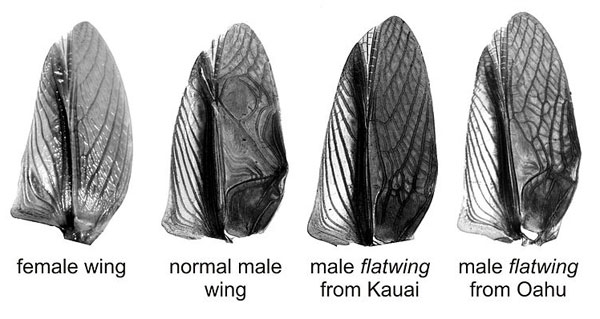Science News
Silent Crickets
June 4, 2014
by Molly Michelson

Parasites and their hosts face off in an evolutionary “arms race—a very deadly game, played by two players that have a lot of vested interest in winning.” The Academy’s microbiologist Shannon Bennett was referring to viruses and human hosts when she made this remark. But the same can be said for any parasite, including parasitic wasps, flies, and their hosts.
Parasitic wasps and flies often use their insect host as homes for their eggs and larvae. They insert an egg into the unsuspecting host. The egg hatches, the larva grows and develops, and eventually the new parasitic wasp or fly emerges, killing the host as it does so. Deadly game, remember?
But if the parasite can’t find its host, then what? Deadly game in reverse—the wasps and flies cannot reproduce!
Scientists studying Hawaiian field crickets (Teleogryllus oceanicus) on the island of Kauai discovered that some of the male crickets avoid parasitoid flies (Ormia ochracea) by remaining quiet. Quiet crickets? Aren’t those insects known for the noise they make rubbing their wings together?
It’s not a choice—these silent crickets have developed a mutation—flatwings—and they are no longer able to chirp. Their wing structure changed, and they have effectively lost their instruments. Scientists noticed these mutant crickets on Kauai in the early 2000s, where their population rebounded after the parasitoid flies almost decimated field crickets. In fact, the quiet crickets were so successful, they outnumber noisy ones.
Two years later, scientists noticed the same thing on Oahu—quiet, flatwinged crickets avoiding those nasty flies. They wondered—did crickets with the mutation island-hop from Kauai to Oahu, or did the mutation, or novel trait of flatwings, originate independently on each island?
When the team looked closely at the wings of crickets on each island, they noticed obvious differences (see image, above). Further experiments in the lab showed that the silent wings in both cricket populations could be traced to single, sex-linked genes. However, when Sonia Pascoal, of the University of St Andrews, performed a genome-wide scan, it showed that the genes responsible are linked to different genetic markers.
Remarkably, the same trait arose at about the same time on two islands, but independently and in different underlying ways.
“There is more than one way to silence a cricket,” says Nathan Bailey, also of the University of St Andrews. “Evolution by natural selection has produced similar adaptations from different genetic starting points in what appears to be the blink of an eye in evolutionary time.
“This is an exciting opportunity to detect genomic evolution in real time in a wild system, which has usually been quite a challenge, owing to the long timescales over which evolution acts,” Bailey adds. “With the crickets, we can act as relatively unobtrusive observers while the drama unfolds in the wild.”
Drama and a deadly game.
The research was published last week in Current Biology.
Image: Nathan Bailey